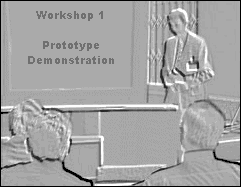Making intranets effective in use
Av Alexander Piatidis, March 2004
Early in 2004 Usability Partners conducted an interview study of those responsible for intranets in 20 large companies* in Sweden. One of the objectives of the study was to investigate how intranets were developed in order to best support staff in their work. Below is a brief summary of some of the study findings (a longer document about the study is available in Swedish.
The importance of "usability", or as many called it, "user-friendliness", was relatively well known to those interviewed. Indeed, 16 of 20 had conducted some form of usability work, and there was significant interest in the area.
Methods used
The most common methods that were used as a basis for developing and improving Intranets based on user input were group discussions (6 of 20), user surveys (5 of 20) and user tests (4 of 20). A few companies used more than one method.
Work with usability gave good results
Almost all who had conducted usability work of some form felt that it had given good results. Concrete examples of outcomes mentioned included new navigation structures, terminology improvements and adaption of interfaces to better suit users' work.
Most common user tasks rarely analysed
Certain user tasks are more critical and/or likely to be conducted more frequently than others on Intranets, and ensuring that there is good support for such tasks has obvious benefits. However, the different tasks conducted by users (and their frequency) was not something that companies had investigated, other than in some cases to track the most commonly visited pages.
Some reflections
There was significant interest in working with usability, which we naturally feel is positive. However, methods used varied significantly between companies, as did the extent to which usability work was a structured and a routine part of working with the Intranet.

Often methods such as 'group discussions' and 'user surveys' were mentioned. These are useful in capturing user opinions and ideas for new development. However, to ensure an intranet supports users well in their work also requires objective studies that look at how users interact with the intranet. Indeed, the user-based usability tests of prototypes during design was the most commonly used method by those responsible for 'the 10 best intranets of 2003' (Nielsen Norman Group).
In conclusion...
Good intranet usability can have significant benefits for companies - less time wasted, fewer support calls, more satisfied staff and better customer service, which those companies participating in the study realised. Whilst some usability work is always better than none at all, there is an apparent need for a more structured approach to usability work and a better understanding the results that different types of activities can give.
* Companies participating in the study:
AGA, AstraZeneca, Billerud, Bredbandsbolaget, COOP, Eniro, Graninge, ICA, NCC, OM, SAS, SCA, SCC, SEB, SPP/Handelsbanken tryggliv, Swedish Match, Tre, Trygg Hansa, UPC, Vattenfall
Related articles:
- Ten Best Intranets of 2003 (Nielsen's Alertbox, 2003-10-13)
- A list of methods and when they can be used (Usability Partners)
- A successful information structuring activity (CIO Magazine, April 1999)
- "Voodoo usability" - the limitations of focus groups and surveys (Nielsen's Alertbox, 1999-12-12)
Did you find this editorial interesting?
You might like to read some of our other editorials.
Please send us an email if you have any comments or suggestions!